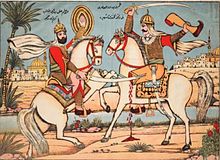Trench battle

The trench battle or the trench war (غزوة الخندق / Ġazwatu'l-Handaq ) was the attack an alliance of the Quraysh , some other strains and Abyssinian mercenaries to Medina in 627 AD.. Mohammed did - the Islamic According to historians the Council Salmān al-Fārisīs following - in defense of the oasis a ditch move around Medina, which is why the attack became known as the battle of the trenches . The attackers did not know how to counter this strategy, which was previously unknown in Arabia , which is why they began a siege of the oasis , during which primarily diplomacy was pursued. After two weeks, the attackers withdrew without having overcome the ditch.
Reports of the battle are only given in Islamic historiography , especially in maghazi and sira literature. In the Koran the battle of the trenches is dealt with in sura 33 , verses 9 to 25.
prehistory
Arriving in Yathrib after the hijra , the emigrants lacked any financial means of livelihood, which is why they began - following ancient Arabic custom - to plunder the Quraish caravans, which were now viewed as alien after the expulsion of the Prophet and his Meccan followers. The first caravan raids were unsuccessful; the first successful raid took place in January 624 AD. A major military confrontation between Mohammed and the Quraish broke out in March of the same year at Badr , from which Mohammed and his followers emerged victorious despite being numerically inferior. To avenge themselves for their defeat at Badr, the Quraish decided a year later to attack Medina. This attack, which was victorious for the Quraish, became known as the Battle of Uhud . This battle was followed by the expulsion of the Banu Nadir , some of whom fled to Syria, some settled in Chaibar and from there supported the Quraish in the battle of the trenches.
Course of the battle
The Meccans had started preparing to attack Medina two years earlier, after the Battle of Uhud, and gained the support of several tribes. In the end they had assembled an army of around 10,000 and 7,500 men with 600 horses. However, Mohammed, who had about 3,000 men at his disposal, had already harvested the grain in the north of the oasis, so that the fodder for the Meccan cavalry quickly became scarce upon their arrival . When he learned of the imminent departure of the enemy army from Mecca, Mohammed ordered his followers to dig a trench. After six days, the work on this trench, in which Mohammed had personally participated, was finished.
The Meccan cavalry, who were actually superior to the Muslim troops, were pushed back when they tried to cross the trench. The attackers seem to have avoided an attack with their infantry on the basis of experience from previous battles with the Muslims. Because this ruined their main strategy of attack, the Quraish and their allies began a siege of Medina, in which they were completely inexperienced. After two weeks of no major military activity, the siege ended after the Confederation was dissolved.
The failure of the attack greatly strengthened Muhammad's position in Medina and led to dejection in Mecca. The Banu Quraiza were annihilated immediately after the battle .
Individual evidence
- ↑ a b Irving M. Zeitlin: The Historical Muhammad . Polity Press, 2007. p. 12
- ↑ a b Hartmut Bobzin: Mohammed . CH Beck, 2002. p. 103
- ^ W. Montgomery Watt: Muhammad at Medina . Oxford University Press, 1962. p. 36
- ↑ Rudi Paret: Mohammed and the Koran. History and proclamation of the Arab prophet . Kohlhammer, 2001. p. 128
- ^ The Encyclopaedia of Islam . New Edition. Brill, suffering. Vol. 7, p. 852 ( Naḍīr, Banu'l- )
- ^ W. Montgomery Watt: Muhammad. Prophet and Statesman . Oxford University Press, 1961. pp. 166 f.
- ^ W. Montgomery Watt: Muhammad. Prophet and Statesman . Oxford University Press, 1961. p. 167
- ^ W. Montgomery Watt: Muhammad. Prophet and Statesman . Oxford University Press, 1961. p. 168
- ↑ For a description of the course of the battle see: The Encyclopaedia of Islam . New Edition. Brill, suffering. Vol. 4, p. 1020 ( Khandak )
- ^ The Encyclopaedia of Islam . New Edition. Brill, suffering. Vol. 4, p. 1020
literature
- The Encyclopaedia of Islam . New Edition. Brill, suffering. Vol. 4, p. 1.020 ( Khandak )
- W. Montgomery Watt: Muhammad. Prophet and Statesman . Oxford University Press, 1962. pp. 166-171